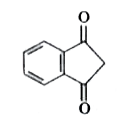Which of the following acid will release maximum amount of heat when completely neutralised by strong base NaOH?
1MHCI
1MHNO3
1MHCIO4
1MH2SO4
The correct Answer is:D
To determine which acid releases the maximum amount of heat when completely neutralized by a strong base like NaOH, we can follow these steps:
Step 1: Identify the Acids
Let's consider the acids given in the options:
1. HCl (Hydrochloric acid)
2. HNO3 (Nitric acid)
3. HClO4 (Perchloric acid)
4. H2SO4 (Sulfuric acid)
Step 2: Understand the Neutralization Reaction
When an acid (HA) is neutralized by a strong base (NaOH), the reaction can be represented as:
HA+NaOH→NaA+H2O
The heat released during this reaction (ΔH) depends on the number of moles of H+ ions produced by the acid.
Step 3: Determine the Number of H+ Ions
- HCl dissociates to give 1 mole of H+.
- HNO3 dissociates to give 1 mole of H+.
- HClO4 dissociates to give 1 mole of H+.
- H2SO4 dissociates to give 2 moles of H+ (it dissociates in two steps:
1. H2SO4 → H+ + HSO4−
2. HSO4− → H+ + SO4^2−)
Step 4: Compare the Heat Released
Since the heat released (ΔH) is directly proportional to the number of H+ ions produced:
- HCl, HNO3, and HClO4 each produce 1 mole of H+.
- H2SO4 produces 2 moles of H+.
Step 5: Conclusion
Since H2SO4 produces the highest number of H+ ions (2 moles), it will release the maximum amount of heat when neutralized by NaOH.
Therefore, the acid that releases the maximum amount of heat upon complete neutralization by NaOH is H2SO4.
Final Answer
H2SO4 (Sulfuric acid) releases the maximum amount of heat when completely neutralized by NaOH.
---
Let's consider the acids given in the options:
1. HCl (Hydrochloric acid)
2. HNO3 (Nitric acid)
3. HClO4 (Perchloric acid)
4. H2SO4 (Sulfuric acid)
When an acid (HA) is neutralized by a strong base (NaOH), the reaction can be represented as:
HA+NaOH→NaA+H2O
The heat released during this reaction (ΔH) depends on the number of moles of H+ ions produced by the acid.
- HCl dissociates to give 1 mole of H+.
- HNO3 dissociates to give 1 mole of H+.
- HClO4 dissociates to give 1 mole of H+.
- H2SO4 dissociates to give 2 moles of H+ (it dissociates in two steps:
1. H2SO4 → H+ + HSO4−
2. HSO4− → H+ + SO4^2−)
Since the heat released (ΔH) is directly proportional to the number of H+ ions produced:
- HCl, HNO3, and HClO4 each produce 1 mole of H+.
- H2SO4 produces 2 moles of H+.
Since H2SO4 produces the highest number of H+ ions (2 moles), it will release the maximum amount of heat when neutralized by NaOH.
H2SO4 (Sulfuric acid) releases the maximum amount of heat when completely neutralized by NaOH.
Topper's Solved these Questions
- CHEMISTRY AT A GLANCEBOOK - ALLENCHAPTER - CHEMISTRY AT A GLANCEEXERCISE - INORGANIC CHEMISTRY
300 Videos
- CHEMISTRY AT A GLANCEBOOK - ALLENCHAPTER - CHEMISTRY AT A GLANCEEXERCISE - ORGANIC CHEMISTRY
472 Videos
- Chemical EquilibriumBOOK - ALLENCHAPTER - Chemical EquilibriumEXERCISE - All Questions
30 Videos
- ELECTROCHEMISTRYBOOK - ALLENCHAPTER - ELECTROCHEMISTRYEXERCISE - EXERCISE -05 [B]
38 Videos
Similar Questions
Knowledge Check
Which metal catalyzed reaction would release the maximum amount of heat per CH2 unit ?
Acyclopropane +H2→ propaneBcyclobutane +H2→ butaneCcyclopentane +H2→ pentaneDcyclohexane +H2→ hexaneWhich of the following compounds exhibit acid base reaction with NaOH?
A B
B C
C D
D
Which of the following is strong Lewis base?
View SolutionIn which of the following maximum amount of heat is released if one mole of each reactant is taken?
View SolutionWhich of the following alkenes does not undergo rearrangement on heating with a strong acid?
View SolutionWhich of the following alkenes does not undergo rearrangement on heating with a strong acid?
View SolutionConductance measurements and be used to detect the end point of acid-base titrations. Which of the following plots correctly represents the end point of the titration of strong acid and a strong base?
View SolutionWhich of the following acid will form an (a) Anhydride on heating and
(b) Acid amide on strong heating with ammonia?
View Solution
